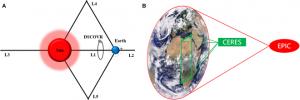AI enhances global radiation monitoring from space
GA, UNITED STATES, August 1, 2025 /EINPresswire.com/ -- This study presents a machine learning approach to estimate the top-of-atmosphere (TOA) shortwave radiation flux from Deep Space Climate Observatory / Earth Polychromatic Imaging Camera (DSCOVR/EPIC) satellite observations. By leveraging neural network models, the research overcomes traditional challenges, offering a more efficient and precise method for monitoring global radiation flux, vital for understanding Earth's energy balance and climate dynamics.
The Earth's radiation budget (ERB) is essential for understanding climate dynamics, driven by the balance between incoming solar radiation and outgoing radiation. Accurate measurement of shortwave radiation at the top of the atmosphere (TOA) is a critical aspect of ERB monitoring. Conventional methods require complex angular distribution models (ADMs), which can be difficult to apply to new satellite data sources, such as those from the Deep Space Climate Observatory / Earth Polychromatic Imaging Camera (DSCOVR/EPIC) satellite. Based on these challenges, or due to these issues, further research is necessary to develop simplified, more efficient methods for deriving TOA shortwave flux.
A research team from Shenzhen University and the China Meteorological Administration has introduced a novel deep learning approach to estimate TOA shortwave radiation using images from the DSCOVR/EPIC satellite. Published on July 2, 2025, in Journal of Remote Sensing, the study addresses the absence of dedicated ADMs for EPIC data and leverages artificial intelligence to directly infer radiation flux. This method helps overcome current limitations in satellite-based climate monitoring, potentially enabling more accurate and frequent assessments of Earth's energy balance from deep space.
The study successfully developed 36 neural network models to estimate TOA shortwave flux from DSCOVR/EPIC observations, validated against the established CERES data products. These models demonstrated high accuracy, with a 97% correlation to the global radiation flux. The machine learning models outperformed traditional angular distribution methods by simplifying the process and improving the consistency and efficiency of the flux estimations, especially for regions with varying atmospheric and surface conditions.
The researchers used a large dataset of EPIC and CERES measurements, spanning from 2015 to 2021, to train the neural network models. The data were divided by surface types and sky conditions, ensuring that the models could handle diverse environmental scenarios. Through a series of tests, the neural network models were able to estimate radiation fluxes with a higher correlation to CERES products than previous albedo-based models. Notably, the model's ability to account for varying cloud cover and surface types was crucial for improving accuracy in flux estimates, especially in areas with complex atmospheric interactions like water bodies and urban areas.
"Machine learning offers a transformative way to address the limitations of traditional methods for estimating Earth’s radiation flux," said Huizeng Liu, lead researcher. "Our models not only simplify the process but also offer a much more precise way to monitor radiation flux on a global scale, which is vital for understanding climate change and informing global policy decisions."
The study utilized data from the DSCOVR/EPIC and CERES satellites, focusing on multispectral imaging and atmospheric measurements to estimate shortwave radiation. The neural networks were trained on EPIC's L2 composite product, with a variety of surface types and cloud conditions considered. The Levenberg–Marquardt algorithm was employed to optimize model parameters, while the models' performance was tested using an independent dataset to validate their accuracy and consistency across different conditions.
This breakthrough has significant implications for future Earth observation systems, particularly with the development of Moon-based observation platforms and geostationary satellites. The methods applied in this study can be adapted to these new technologies, offering more consistent and accurate monitoring of Earth's radiation. As satellite data becomes more abundant, these machine learning models will play a pivotal role in advancing climate monitoring and addressing global environmental challenges.
References
DOI
10.34133/remotesensing.0373
Original Source URL
https://doi.org/10.34133/remotesensing.0373
Funding Information
This research was funded by the National Natural Science Foundation of China (grant no. 42371337), the Guangdong Basic and Applied Basic Research Foundation (grant no. 2023A1515011946 and 2024A1515011388), the Shenzhen Science and Technology Program (grant no. JCYJ20230808105709020 and JCYJ20240813142621029), and the Shenzhen Municipal Government Investment Project (no. 2106-440300-04-03-901272).
Lucy Wang
BioDesign Research
email us here
Legal Disclaimer:
EIN Presswire provides this news content "as is" without warranty of any kind. We do not accept any responsibility or liability for the accuracy, content, images, videos, licenses, completeness, legality, or reliability of the information contained in this article. If you have any complaints or copyright issues related to this article, kindly contact the author above.

